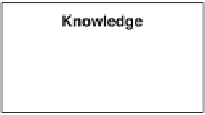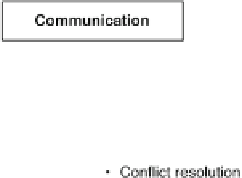Information Technology Reference
In-Depth Information
Fig. 8.3
A theory of the components of teamwork (based on a diagram by Salas et al.
2005
)
Table
8.1
notes several factors that influence team performance based on a
review of modeling teamwork (Morgan et al.
2010
). The importance of each of the
factors will depend on the task itself, and the context in which it is performed.
Note that although we refer to team, these factors also apply to groups.
An example of a team is shown in Fig.
8.4
. Much of the research in this area
has been carried out in critical dynamic domains, such as aviation or defense,
where good teamwork has high payoffs (and, more importantly, poor teamwork
can lead to great losses). In addition to the way that teams are made up, and how
the individual members work together, team performance is also affected by the
availability of resources to carry out the task at hand. These includes physical
resources like space, computers, networks, and databases, as well as intellectual
and administrative support above and below the team in the organization (see
Booher and Minninger
2003
; Brooks
1975
for overviews of resourcing issues).
Achieving good teamwork is difficult. The situation is complicated because of the
need to consider the interaction of multiple people, each with different backgrounds
(knowledge, culture, and so on), which will influence their behavior. It is also
important to take appropriate account of task-related factors, because the task
structure, for example, may not readily map onto the team's structure. Here we draw
on and extend Kozlowski and Ilgen's (
2006
) review to highlight areas of importance.
8.3.2 Team Size
The size of a team affects performance. If the team is small and its size is constant,
it may be possible for communication and collaboration to take place directly
between members. The group's size has a strong effect on intra-group interaction,
as well as inter-group perceptions. Group size seems not only to influence the
















































Search WWH ::

Custom Search